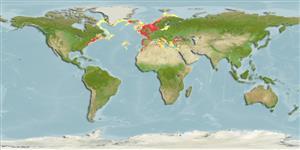Classification / Names
Common names from other countries
Main reference
Size / Weight / Age
Max length : 60.0 cm FL male/unsexed; (Ref. 35388); common length : 30.0 cm FL male/unsexed; (Ref. 168); max. published weight: 3.4 kg (Ref. 9988); max. reported age: 17 years (Ref. 207)
Length at first maturity
Lm 28.7, range 34 - ? cm
Environment
Marine; brackish; pelagic-neritic; oceanodromous (Ref. 51243); depth range 0 - 1000 m (Ref. 54254), usually 0 - 200 m (Ref. 54254)
Climate / Range
Temperate, preferred 10°C (Ref. 107945); 70°N - 25°N, 77°W - 42°E
Distribution
Short description
Dorsal
spines
(total): 8 - 14;
Dorsal
soft rays
(total): 113;
Anal
spines: 1;
Anal
soft rays: 12 - 13;
Vertebrae: 31. This species has the following characters: no well developed corselet; interpelvic process small and single; anal fin spine conspicuous, joined to the fin by a membrane but clearly independent of it; anal fin origin opposite that of second dorsal fin; no swim bladder; first haemal spine anterior to first interneural process; 21-28 interneural bones under first dorsal fin; markings on back oblique to near vertical, with relatively little undulating; belly unmarked (Ref. 168).
IUCN Red List Status (Ref. 115185)
Threat to humans
Harmless
Human uses
Fisheries: highly commercial; gamefish: yes
Tools
Special reports
Download XML
Internet sources
Estimates of some properties based on models
Phylogenetic diversity index
PD50 = 0.5625 many relatives (e.g. carps) 0.5 - 2.0 few relatives (e.g. lungfishes)
Trophic Level
3.6 ±0.2 se; Based on diet studies.
Resilience
Medium, minimum population doubling time 1.4 - 4.4 years (rm=0.33-0.56; K=0.23-0.27; tm=2-3; tmax=17; Fec=200,000)
Vulnerability
Moderate vulnerability (44 of 100)
Price category
